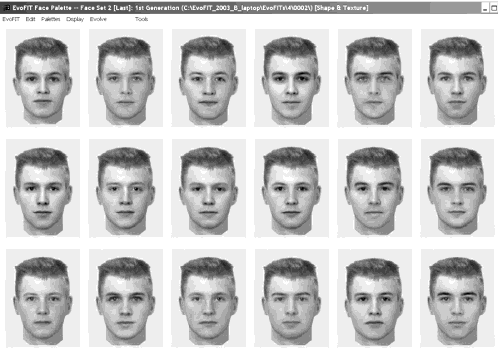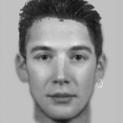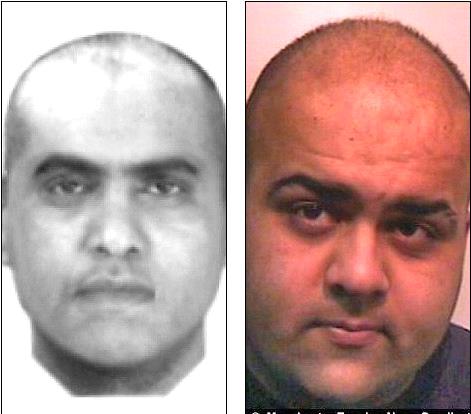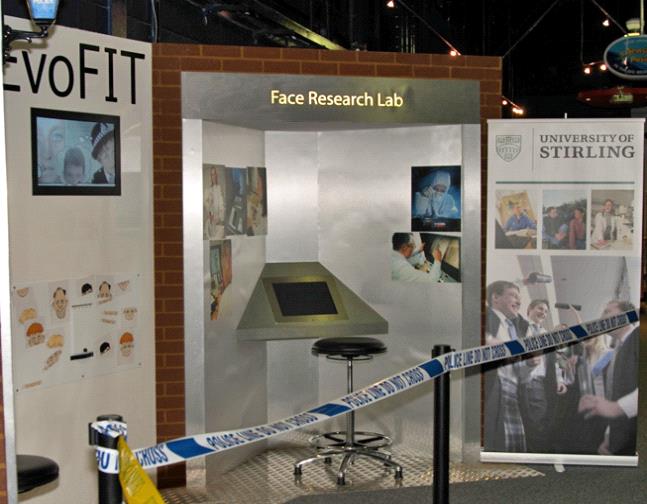EvoFIT: Applying Psychology To The Identification Of Criminals
Submitting Institution
University of StirlingUnit of Assessment
Psychology, Psychiatry and NeuroscienceSummary Impact Type
LegalResearch Subject Area(s)
Psychology and Cognitive Sciences: Psychology
Summary of the impact
Our research has made an outstanding contribution to the ability of
police forces to apprehend criminal suspects, particularly in cases of
serious violent crime. EvoFIT is a facial composite system (software and
procedures), designed to help victims and witnesses of crime to create a
likeness of the perpetrator's face. It was conceived by Professor Peter
Hancock in the mid-1990s and has been developed into an effective system
that is in use by police forces across the UK and abroad. Forces using
EvoFIT have actively collaborated with assessment of the system, and
evidence from field trials clearly demonstrates the impact: a
world-leading 25-60% of composites made with EvoFIT directly lead to an
arrest, four times better than the best previous system used by police
forces. Our novel methods for interviewing witnesses and for presentation
of composites have enhanced the success of EvoFIT, and are now
incorporated in competitor composite systems used by other police forces.
Underpinning research
The initial research for EvoFIT derived from Hancock's work at Stirling
on the Principal Component Analysis (PCA) of natural images and on genetic
algorithms. Computer analysis of faces was compared with human perceptions
of the same face1. A model of human face perception, from PCA
image analysis through to identification, won the BPS Cognitive Section
`Award For Best Paper' in 20002. PCA analysis provided Hancock
with a novel way to generate face images, while genetic algorithms
provided a way to search for the best likeness. This fundamental research
led to the conception of EvoFIT (as shown in Figure 1).
 Figure 1. A screenshot of EvoFIT
Figure 1. A screenshot of EvoFIT
A pilot system3 led to funding from EPSRC in 1997, which
supported a PhD student, Charlie Frowd. EvoFIT was further developed
through a link grant (DTI/EPSRC) with ABM, a company selling security
products, and then by another EPSRC grant (2005-7), which employed both
Frowd and Alex McIntyre (Stirling RPG). Crucial to the success of the
system is its development in Stirling's face laboratory, where the focus
is on how humans perceive faces. Hancock and Frowd have applied this
knowledge, along with basic principles of conducting research with human
participants, to developing and evaluating the EvoFIT system. An early
contribution was to establish a `gold standard' method for evaluating
composite systems, so that we were able to benchmark improvements to the
system with confidence4.
Having established the basic face processing technology and evaluation
procedures we then considered all aspects of the process of producing a
facial composite, from interviewing the witness to the best way to present
the resultant image. Below we provide examples of how psychological theory
has been used, one from each stage of the process.
1. Interviewing the witness: The established method is a
`Cognitive Interview', which includes a phase of context reinstatement,
free recall and then prompted recall about each facial feature in turn.
Witnesses are often unable to describe features well, and a key advantage
of EvoFIT over traditional feature-based composite systems is that it does
not require a detailed description. Another potential problem is a verbal
overshadowing effect: having described a feature, witnesses may try to
create something that matches the description rather than their memory. We
developed a novel `Holistic Cognitive Interview', where witnesses are
asked to rate the remembered face for general characteristics such as
intelligence, selfishness and aggressiveness. It turned out that a
combination of feature description followed by the holistic ratings
produced the most identifiable composites5.
2. Focusing on internal face features: Studies of human face
perception show that unfamiliar faces tend to be remembered by external
features such as hair, whereas familiar ones are recognised by the
internal features. While witnesses are dealing with an unfamiliar face,
the composite needs to be recognised by someone familiar with the
perpetrator. We therefore hypothesised, and subsequently demonstrated,
that blurring the external parts of the face during composite creation
would force witnesses to concentrate on the inner features, resulting in
more recognisable composites6.
3. Animated caricature based composites: Studies of human memory
suggest that performance is enhanced for distinctive stimuli, leading us
to explore the possibility of caricaturing the composites. Caricaturing
emphasises those parts of a face that are distinctive and there is
evidence that caricatured line drawings of faces are more recognisable.
Facial composites are typically poorly recognised and we tested whether
caricaturing would improve this. The best format turned out to be a moving
image, shifting slowly between caricature and anti-caricature. This
technique is applicable to composites made by any system, not just EvoFIT,
and indeed works especially well for relatively poorly recognised
composites from traditional composite systems7.
Until 2007, the work was carried out entirely at Stirling; Bruce, by then
at Edinburgh, advised on the `Evolving A Better Composite' grant. Frowd
moved to a lecturing position at University of Central Lancashire in 2007;
since then work has continued at both universities, with Frowd visiting
Stirling regularly to discuss results and plan future work with Hancock
and McIntyre, who remains in Stirling as a postdoctoral researcher.
References to the research
1. Hancock, Burton & Bruce (1996) Face Processing: Human
Perception And Principal Components Analysis. Memory & Cognition,
24, 26-40. [JCR IF 2011 = 1.922; Scopus Citation Count = 108; 5/66 for the
journal that year]
2. Burton, Bruce & Hancock (1999) From Pixels To
People: A Model Of Familiar Face Recognition. Cognitive Science,
23, 1-31. BPS Cognitive Section Best Paper Award. [JCR IF 2011 = 1.376;
Scopus Citation Count = 143; 1/20 for the journal that year]
3. Hancock (2000) Evolving Faces From Principal Components. Behavior
Research Methods, Instruments and Computers, 32, 327-333. [JCR IF
2011 = N/A; Scopus Citation Count = 30; 9/69 for the journal that year]
4. Frowd, Carson, Ness, Richardson, Morrison, McLanaghan & Hancock
(2005) A Forensically Valid Comparison Of Facial Composite Systems. Psychology,
Crime & Law, 11, 33-52. [JCR IF 2011 = .694; Scopus Citation
Count = 44; 2/37 for the journal that year]
5. Frowd, Bruce, Smith & Hancock (2008) Improving The
Quality Of Facial Composites Using A Holistic Cognitive Interview. JEP:
Applied, 14, 276-287. [JCR IF 2011 = 1.754; Scopus Citation Count =
14; 16/34 for the journal that year]
6. Frowd, Pitchford, Bruce, Jackson, Hepton, Greenall, McIntyre,
& Hancock (2011). The Psychology Of Face Construction: Giving
Evolution A Helping Hand. Applied Cognitive Psychology, 25,
195-203. [JCR IF 2011 = 1.667; Scopus Citation Count = 10; 3/127 for the
journal that year]
7. Frowd, Bruce, Ross, McIntyre & Hancock (2007) An
Application Of Caricature: How To Improve The Recognition Of Facial
Composites. Visual Cognition, 15, 954-984. [JCR IF 2011 = 2.049;
Scopus Citation Count = 26; 4/60 for the journal that year]
Funding: All awarded competitively via full peer review.
| Funding body - PIs |
Year |
Amount |
Title/Rating |
| EPSRC – Hancock
|
1997-2000 |
£51K |
An evolutionary face generator |
| EPSRC/DTI Link
Bruce & Hancock
|
2000-2003 |
£172K |
Crime-Vus
(Rated: Outstanding) |
| EPSRC
Hancock, Frowd & Bruce |
2005-2007 |
£224K |
Evolving a better composite
(Rated: Tending to Outstanding) |
| EPSRC Public Engagement
Hancock & Frowd |
2006-2007 |
£36K |
Sensational EvoFIT
(Rated: Tending to Outstanding) |
Details of the impact
EvoFIT performance:
Irrespective of performance in laboratory studies, the real test for a
facial composite system is whether the composites made are successfully
identified, either by the police or members of the public. In the first
case of a trial with Lancashire police, EvoFIT was used with an 11 year
old girl who had been sexually assaulted in a park; this EvoFIT was
identified by two members of the public and the attacker was sentenced to
seven years in prisonA. A photograph of the attacker is shown
in Figure 2, alongside the EvoFIT composite that was used to catch him.

 Figure 2. A sexual predator caught using EvoFIT
Figure 2. A sexual predator caught using EvoFIT
Following this initial success we engaged in a wider series of trials
using a number of different police forces both in the UK and abroad.
During a six-month trial of the system by Lancashire police in 2007-8, 30
composites were made, leading directly to six arrests, a success rate of
20%. Derbyshire police trialled the system for a year from mid-2008; they
produced 57 Figure 2. A sexual predator caught using EvoFIT
composites, of which 19.3% led to arrests. Devon and Cornwall police
started using an updated version of EvoFIT in 2010; during their first
four months, 40% of the composites made led to arrests. In one case, a man
reported himself to the police, since football teammates had identified
the composite and threatened to contact police if he did not. A trial in
Romania, using a specially constructed face-database, generated 24
composites, of which 37.5% led to arrests. These trials are fully
documented and evidence regarding the benefits of EvoFIT is publishedB.
A more recent field trial in Humberside policeC resulted in 21
arrests from 35 composites (60%); this compares with 14% from the previous
three years' use of the E-FIT composite system. An especially high profile
case in South Manchester was solved using EvoFIT and our animated
caricature technique. The same man attacked and raped two young women; the
second of these made an EvoFIT that was shown in local media, including
the Manchester Evening News (Figure 3). A number of people identified the
man as a worker in a local fast food outlet; he confessed and has now been
convictedD.
The development of EvoFIT, and the associated
interviewing and presentation techniques, continues.
This development accounts for the steadily increasing success rate
reported in the field trials. The latest research has demonstrated the
utility of combining the various advancesE, and the science
behind EvoFIT has also been described for a more general audienceF.
 Figure 3. The South Manchester
rapist caught using EvoFIT
Figure 3. The South Manchester
rapist caught using EvoFIT
EvoFIT Reach:
Since 2008, EvoFIT has been used in 14 police forces across the UK, and
throughout Romania, with over 3,000 composites madeG; total
income from sales and support is £106K. While EvoFIT is the primary outlet
for our researchH, some of our techniques are applicable to
other facial composite systems. Animated caricature has been adopted by
both EFIT-V, another third generation systemI, and PRO-fit, an
earlier feature-based systemJ, and the holistic-cognitive
interview works particularly well with PRO-fit and is routinely used with
that system. Because our methods are embedded in rival software our impact
extends to virtually every police force in the UK. In addition, our
research places UK police ahead of other forces internationally — no other
system in the world has been as thoroughly evaluated and demonstrated to
work so well. Consequently, international police forces regularly enquire
about using EvoFIT: it is being evaluated in Israel and Boston (USA).
Geoff Whittaker of the Centre for Applied Science and Technology can speak
to the wider impact of facial imaging in law enforcementK.
Award nominations:
- Nominated for World Technology Award, 2004
- BBC Focus Magazine: one of the top British innovations of 2009
- Cited by the EPSRC as evidence of the impact of the research that it
funds, winter 2009
- Shortlisted for a Praxis Unico Impact Award in 2010
- EvoFIT shortlisted for the Times Higher Research project of 2010
- Caricaturing shortlisted for the Times Higher Research project of 2011
- EvoFIT won the University Excellence Award at TechWorld in 2011
Public engagement:
Hancock and Frowd received EPSRC public engagement funding to build an
EvoFIT installation at the Sensation Science Centre in Dundee, shown in
Figure 4 at its opening. Visitors are able to interact with EvoFIT at a
specially designed station, where they can try evolving a composite for
themselves, while another station explains the science behind the exhibit.
The centre attracts over 70,000 visitors per year, representing a
significant impact on public understanding of the science of face
identification. Public engagement funding from the BPS (awarded in 2012)
is currently being used to support the development of new installations
that are due to open in 2013 at the Glasgow and Bristol Science centres
(350,000 and 185,000 visitors per year respectively). EvoFIT has been
featured on television, including Crimewatch and `The One Show'.
 Figure 4. The opening of the EvoFIT
exhibit at Dundee Science Centre
Figure 4. The opening of the EvoFIT
exhibit at Dundee Science Centre
Sources to corroborate the impact
A. An early case in Lancashire where EvoFIT was instrumental in
solving the crime: www.tinyurl.com/qbkdlnm
B. Details of field trials with Derbyshire, Devon & Cornwall
and Romanian police: Frowd, Hancock, Bruce, et al., (2011).
Catching More Offenders With EvoFIT Facial Composites: Lab Research And
Police Field Trials. Global J. of Human Social Sci., 11, 46-58. www.tinyurl.com/oopmljy
C. Details of recent EvoFIT field trials with Humberside police:
Frowd, et al., (2012). Catching Even More Offenders with EvoFIT
Facial Composites. In Stoica, et al., (Eds.) IEEE Proceedings
of 2012 Third Int. Conf. on Emerging Security Technologies, DOI
10.1109/EST.2012.26 (pp. 20-26). www.tinyurl.com/op5mlu9
D. A Manchester case where an animated EvoFIT led directly to the
arrest of a serial rapist: www.tinyurl.com/pzs3rcn
E. Details of the latest multi-technique lab trials of EvoFIT:
Frowd, et al., (2013). Whole- Face Procedures For Recovering
Facial Images From Memory. Sci. & Justice, 53, 89-97. www.tinyurl.com/nres7w5
F. Article summarizing key developments: Frowd, Skelton, Atherton
& Hancock (2012). Evolving An Identifiable Face Of A Criminal. The
Psychologist, 25, 116-119. www.tinyurl.com/q9gvqhb
G. Police contacts to verify impact (contact details supplied with
REF submission): Derbyshire Constabulary; East Yorkshire; Lancashire.
H. Commercial website for EvoFIT: Website also contains details of
holistic-cognitive interview, animated composite, customer testimonials
and details of media coverage: www.EvoFIT.co.uk
I. A 3rd generation commercial system (EFIT-V)
incorporating our animated caricature: www.visionmetric.com (contact
supplied)
J. PRO-fit `feature' system, including our holistic-cognitive
interview & animated caricature: www.tinyurl.com/pwhxuks
K. Contact to verify use of imaging technology in law enforcement:
(contact supplied) CAST.